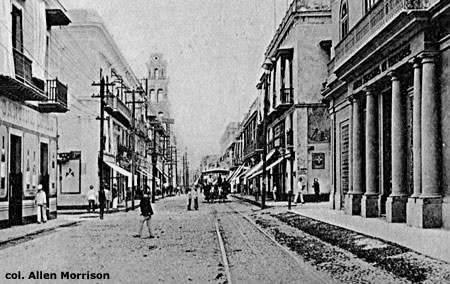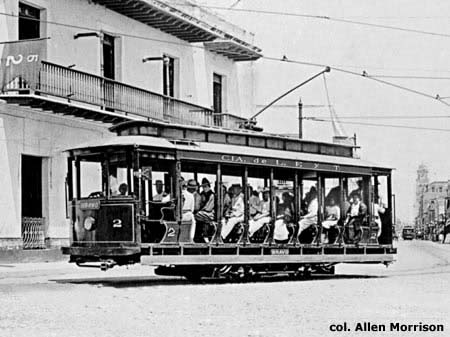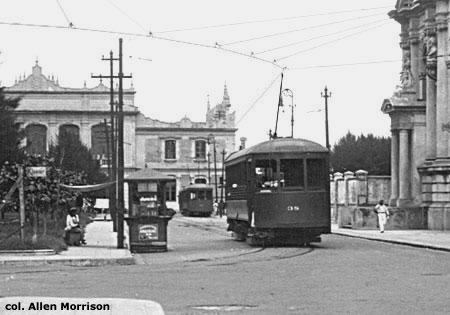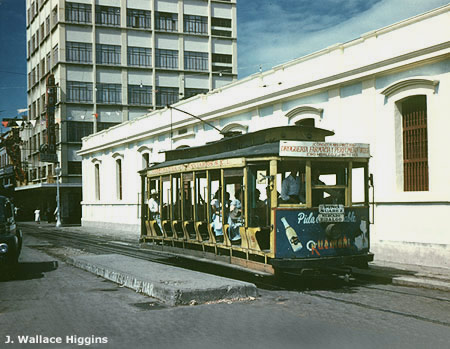As the first port of call for explorers, pirates, and immigrants alike, Veracruz has been held in high regard as a part of Mexican history. For railway enthusiasts, it was the eastern end of what became Mexico's first steam railway to Mexico City, some 273 miles away and for many immigrants, an entire world. For traction enthusiasts, it was site of only the second horsecar railway in the entire country, and one with a very descriptive but unwieldy name. Despite this, and being in the shadow of the
Mexico City Streetcar system in both size and reach, the
Sociedad Cooperativa de Transportes Urbanos y Sub-Urbanos de Veracruz (SCTV) remained a stalwart part of the city for nearly eighty years, and a welcome haven for sold-off, secondhand streetcars. On today's (belated) Trolley Thursday, we're at the True Crossroads as we look back on the streetcars of this Heroic City.
Another Tram In The Wall
 |
An 1860 map of Veracruz, showing the original city limits within the Spanish fort.
(Francisco Garcia and C. Castro) |
The first horsecar line in Veracruz began construction in 1863 under the direction of local financier Ramòn de Zangròniz, whose franchise had the street railway built within the walls of the old Spanish Settlement on the harborfront, bordered by Avenida Independência on the southwest. This line, which went unnamed, opened in 1864, only the second-ever streetcar line after Mexico City's, which first opened in 1858. In 1865, Zangròniz was granted his second franchise to build a 70-mile "proto-interurban" line from the port of Veracruz, to the capital of the eponymous state, Xalapa (or Jalapa). Construction began on the northwest-bound line shortly after, but stopped after 8 years and 35 miles due to Zangròniz running out of capital. He sold the company to
Ferrocarril Mexicano (FM) in 1873 and the line was completed by 1875. With a total distance of 54 miles between Jalapa and the harborfront, as well as an elevation gain of 4500 feet towards Jalapa, the trip took 11.5 hours outbound from the harbor and required five changes of mules; the downhill run inbound only took 9 hours by comparison.
 |
A normal pre-electric scene in Veracruz, circa 1905. The view is looking
south along Av. Independencia towards the old railroad station.
(Allen Morrison) |
Back within the city, the second tramway company opened for service in 1875 along Alameda de la Libertad (now Avenida Dìaz Miròn) outside of the fort walls by the
Ferrocarril Urbano de Veracruz (Urban Railway of Veracruz, or FCU). Another horsecar line, it extended down the city's south side and reached the city district of Laguna, before looping back up
Avenida 20 de Noviembre. FCU eventually built five routes through the city over this time until 1885, by which point it became the de facto streetcar company in the city. In 1893, the line to Jalapa closed following the construction the steam railroad
Ferrocarril Interoceàno in 1891, and the mules were quite relieved. Before the end of the 19th Century, a new line had opened with a morbid purpose. The
Ferrocarril del Puerto de Veracruz al Cementerio (Port of Veracruz & Cemetery Railway, PVC) opened in 1894 to serve the
Cementerio Particular Veracruzano (Private Funeral) at the very south of the town in Pateones, and was only ever used by private funeral cars south of Altamirano.
The English Are Electrifying
 |
Brill open-car No. 2 heads south on Av. Independencia from Calle Rayòn, 1906.
Note the old cathedral in this photo and the one above as an orientation point.
(Allen Morrison) |
In 1906, electric development in Veracruz really began with (what else?) a company registered in London, England. The
Compañìa de Luz, Fuera y Tracciòn de Veracruz (Veracruz Light, Power & Traction Company, or CLFT) was registered on July 28, 1906, and electrification was swift. Replacing the old horsecars built by the John Stephenson Company of New York, New York, USA, were ten single truck, open-side summer cars from
J.G. Brill of Philadelphia, Pennsylvania, USA, which arrived at the port on September 16, 1907. The first three electrified lines were inaugurated in 1908 and ran from the
Ferrocarril Interoceàno railway station, on Avenida Independencia and Calle Montesinos by the harbor front, to the old railway station on Calle Rayòn. From here, the services split off, as the "Bravo" Line took Avenida Bravo back up, the "Playa" Line headed east for the harbor front before returning north on Avenida Hernàndez, and the "Laguna" Line ran down to the carhouse on Calle Uribe before meeting the funerary trams at Avenida Enrìquez and going back up 20 de Noviembre.
 |
A "Playa" car running west on Avenida Malecòn, past the ornate Lighthouse Tower.
(Allen Morrison) |
 |
Open Car No. 7 on the "Laguna" line, headed
for the bullfights in an unknown year and location.
(Jim Hutzler) |
The CLFT also lent itself to some interesting operations around this time. For one, the three lines I just described were all loop lines instead of end-to-end, so streetcars did not need to change direction at each end of the line (and no double track either). All routes were also only lined south through Avenida Independencia, but after splitting off, took five different streets back up to the new train station. Even odder, their Brill open-cars were the only ones reported to have open center aisles, rather than solid bench seating across the car's width. Services remained unchanged until 1911, when CLFT ordered eight new open cars between 1911 and 1914 to inaugurate a new fourth electric line on Avenida Pino Suàrez, a few blocks west of Bravo. The CLFT also maintained a horsecar line on Avenida Madero until the 1930s. More streetcars came from Brill in 1922, this time an enclosed double-truck streetcar with controls at one end. Local carhouse employees would later tell visiting traction enthusiasts that these cars either came secondhand from Tampico or
Philadelphia, but nobody was ever sure.
 |
CLFT No. 35 crowds Avenida Independencia with another trolley car, 1924.
(Allen Morrison) |
 |
Two streetcars load up on Avenida Repùblica at the new Mexicano station, 1930.
(Allen Morrison) |
The final big change for the CLFT came in about 1920, when a major redevelopment of the old city walls and old railroad station called for the rearrangement of the tram lines. One interesting redirection was that Streetcars traveling west along Parque Zamora now traveled on the left side at 20 de Noviembre and south along Avenida General Prim for a short stretch, leading to a very odd and insular case of left-hand streetcar running in North America. The Laguna line was also similarly moved off Avenida Diaz Miròn onto Avenida Gonzàlez Pàges. Unfortunately, these moves were so expensive that not only was the CLFT thrown into a financial crisis, there was also a series brief streetcar strikes over the next decade. In 1927, the streetcars completely shut down for four months while the CLFT went into receivership, being eventually snatched up by US conglomerate
Electric Bond & Share in 1929. In 1932, the Mexican Government officially took over the insolvent street railway and, in a rare act, allowed its own employees to run the company locally, creating the
Cooperativa de Tranviarios y Similares del Puerto de Veracruz (Port of Veracruz Co-Operative of Tramways and Similar, CTS).
 |
A map of the Veracruz system at its height in 1965, with defunct lines shown in dashed patterns.
(Allen Morrison) |
Don't Worry About the Government
 |
Ex-El Paso Birney No. 103 at Villa del Mar beach in 1978.
(Allen Morrison) |
The first thing the CTS did was to make the new railway more fun for its passengers to use, as they opened up a new line along Avenida Flores Magòn to the beach at Villa del Mar in 1935. In 1936, they purchased ten secondhand "Birney" cars from
El Paso, Texas, these cars being originally built by American Car Company of St. Louis in 1920. The bouncy boxes were normally seen handling the waterfront lines alongside their older summer-car counterparts. Under government ownership, the CTS was also able to weather the storm of the Great Depression and, by 1939, had changed its name to the (highly-unwieldy)
Sociedad Cooperativa de Transportes Urbanos y Sub-Urbanos de Veracruz (Cooperative Society of Urban and Suburban Transport of Veracruz, or CSV for short). This name change coincided with the SCV's purchase of the
Ferrocarril del Puerto de Veracruz al Cementerio, at that point the oldest operating funerary streetcar in the world, along with the Avenida Madero horsecar, which it electrified and called the "Panteones" line.
 |
The cemetery entrance loop from a hillside in 1955, with sand staining the dirt road.
(Earl Clark) |
The World's Largest Operating Tramway Museum
 |
Ex-Connecticut car No. 40 sags and groans as it trundles down the "Bravo line" in 1970.
(Frank Butts, Don Ross) |
 |
CSV Nos. 203 (ex-PE 103) and 206 (ex-PE 106) are caught together
as No. 203 is on the "Villa del Mar" route, 1955. They have yet to be repainted
but have already been relettered (and are luckily long enough to support the name).
Note the conversion to single-end operation with the removal of a trolley pole.
(Jerry Squire, Andy Goddard, PERYHS) |
Be it a case of austerity, economy, or simple serendipity, by 1940, Veracruz's streetcars had entered the "Golden Period" of its existence. Traction fans around the world could remember the cheap tours they took to deliberately visit Veracruz whenever they journeyed to South America. Between 1940 and 1960, the CSV had purchased thirty-four secondhand streetcars from around the world, with most even keeping their original colors. The first order of cars (Nos. 41-48) came from the defunct
Connecticut Company of Hartford, Connecticut, USA, in 1940, and were similar in type to the earlier double-truck Brills ordered by the CLFT. These kept their original cream-yellow and red paint and had a new front door added onto the left side, with the rear doors being welded over and one trolley pole taken off. The second order came from Los Angeles' fabulous
Pacific Electric Railway, who sold fifteen redundant
Double Birney cars (Nos. 100-114, later 200-214) after the closure of the Echo Park line. The final order arriving were eleven Mexico City "
Peter Witt" cars (Nos. 600-610) in 1960.
 |
Tourist buses, old Brill open cars, Birneys, and repainted PE double-Birneys
line up for the daily grind in this 1970 view.
(Frank Butts, Don Ross)
|
 |
Brill Car No. 8 on Avenida Independencia in 1953, way past
its own working life and yet looking damn good doing it.
(J. Wallace Higgins) |
Other changes around this time also included rearranged tracks around Parque Zamora (for the last time, now creating a mini loop to Avenida General Prim from Avenida Independência), new tracks in the Reforma district, and the opening of the biggest loop of all: The Reforma Zaragoza line, which was a return loop off the Panteones line to the cemetery that opened in 1957. Another complete loop that opened was the Cortès Lerdo line in 1965, which encircled the city's west side for a full-circuit streetcar tour that anyone could ride. Indeed, it was not unusual at this time to see traction
gringos with cameras, maps, and loud shirts rubbing shoulders with Veracruzanas using the streetcars to go to work or commute through the city. The SCV took this tourism in stride and had some of its open cars rebuilt into closed cars for better safety, while also keeping their secondhand fleet in as close to good operational condition as they could get.
 |
SCV No. 1, originally a Brill open-car, now resembles a Birney as it trundles down the street in this February 1970 view.
(Frank Butts, Don Ross) |
A Quiet End
 |
"New" No. 001 in March 1979, stopped at Parque Zamora.
(Earl Clark) |
 |
The interior of No. 001 in March 1978, showing off the odd center-aisle
that were only ever found in Veracruz's summer cars.
(Allen Morrison) |
Even with the street railway peaking in 1965, and closures occurring shortly after between 1967 and 1976 (including streetcars on Veracruz's mainstreet, Avenida Independencia) that left only the Reforma Zaragoza and Villa del Mar beach lines operational, the tourists kept coming to see the old Los Angeles and Connecticut cars doing their thing. As a compensation and recognition of the importance of tourism in Veracruz, original Brill open-car No. 8 was rebuilt with a flashy red paint scheme and a brand new number "001" for the system's new "Tranvìa del Recuerdo", or "Nostalgia Streetcar." First running on October 23, 1976, it was the last new streetcar service the SCV added and tourists flocked past its 2-peso fare to ride. The special tourist service lasted for five years until the city decided to end streetcar operations very quietly and very peacefully on August 16, 1981. Two days later, on August 18, the motormen and conductors of the
Sociedad Cooperativa de Transportes Urbanos y Sub-Urbanos de Veracruz took all of the remaining cars out on one last celebratory run around the city, flocked to by hundreds traction enthusiasts and mourning citizens. And then, it was all over.
 |
An ex-El Paso Birney No. 101 shares the Bravo Line with ex-Connecticut
car No. 40 in front of the Veracruz Cathedral, September 12, 1966.
(Unknown Photographer, screw Alamy) |
 |
Ex-Veracruz No. 6 is hogging badly in this photo from Texas.
(Don Ross) |
But it was not over for Veracruz's streetcars. Despite most of them, including their second-hand cars, being scrapped, five original Veracruz cars are known to survive in preservation in the United States and Mexico. Open car No. 15 was later sold to a park in Villahermosa, Tabasco state (yes, where the sauce comes from), but has since vanished from history. Open Car No. 6 was originally purchased by the San Antonio-based
Texas Transportation Museum in 1964 as a body and was bandied about on a trailer car for some time after being used on a line to the local Pearl Brewery. It is now under restoration at the
Fort Smith Trolley Museum in Fort Smith, Arkansas, as of 1995. Nos. 9 and 19 (the latter being a rare later-built open car and the youngest surviving) were sold to the
Trolleyville Museum near Cleveland, Ohio in 1961, but after that museum went under, both went their separate ways with No. 9 joining No. 6 at Fort Smith, and No. 19 remaining complete, restored, and operable at the
Illinois Railway Museum in Union, Illinois.
 |
Ex-Veracruz No. 19 is lettered for "Columbia Park & Southwestern" at Trolleyville in
North Olmsted, Ohio, 1960s. The car is still operating at the Illinois Railway Museum.
(Frank Butts, Don Ross) |
 |
Veracruz No. 001 is unloaded from its flatcar at San Francisco
for the 1984 Historic Trolley Festival.
(Market Street Railway) |
The last car surviving is also the most notable. After being retired from the "Tranvìa de Recuerdo" service in 1981, the "new" No. 001 was leased by the City of San Francisco to be used in their annual
"Historic Trolley Festival" during the 1984 and 1985 seasons. No. 001 was refurbished for the festival, given the city logo on its front, and was shipped up by Southern Pacific flatcar to San Francisco. The diminutive car worked alongside San Francisco's other historic machines, including single-truck "dinky"
No. 578 from the
Market Street Railway as well as other cars we'll see as the years go by from Blackpool, England, Porto, Portugal, and Kyoto, Japan. After two seasons, the esteemed car was sent back down to Veracruz where it underwent another cosmetic restoration in the 1990s. Today, it can be seen on display at Parque Zamora in Veracruz's town center, its destination herald still reading "Recuerdo" and its headlight proudly shining as a testament to the deep and varied history of its hometown.
 |
Veracruz No. 001 at its sheltered, outdoor plinth in Parque Zamora, Veracruz, November 2012.
(Thomas Kautzor) |
Thank you for reading today's Trolley post, and watch your step as you alight on the platform. My resources today included Allen Morrison's write-up on
Veracruz's streetcars, the
Market Street Railway of San Francisco, California, the
Fort Smith Trolley Museum of Fort Smith, Arkansas, the
Illinois Railway Museum of Union, Illinois, and the photo credits under each caption. The trolley gifs in our posts are made by myself and can be found under
“Motorman Reymond’s Railroad Gif Carhouse”. On Tuesday, we continue south of the border as we hit up Guadalajara! For now, you can follow
myself or
my editor on Twitter, buy a shirt or sticker from
our Redbubble stand, or purchase my editor's self-developed
board game! It's like Ticket to Ride, but cooler! (and you get to support him through it!) Until next time, ride safe!

































No comments:
Post a Comment